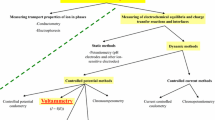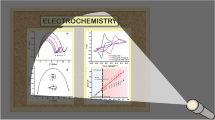Summary
A method is proposed for the electroenzymic determination of alcohols. The biocatalyst used in the potentiometric sensor is an enzyme-coenzyme system (alcohol dehydrogenase and nicotinamide adenine dinucleotide) immobilized on oxidized spectral grade graphite. A mathematical model for the response signals is developed.
Zusammenfassung
Ein Verfahren zur elektro-enzymatischen Bestimmung von Alkoholen wurde vorgeschlagen. Der in dem potentiometrischen Sensor verwendete Biokatalysator ist ein auf oxydiertem Spektralgraphit immobilisiertes Enzym-Coenzym-System (Alkoholdehydrogenase und Nikotinamid-Adenin-dinukleotid). Ein mathematisches Modell des registrierten Signals wurde ausgearbeitet.
Similar content being viewed by others
References
R. D. Braun, K. S. V. Sauthanam, and P. J. Elving, J. Amer. Chem. Soc.97, 2591 (1975).
P. Klossek and H. Aurich, Z. Chemie1976, 59.
M. Aizawa, R. W. Coughlin, and M. Charles, Biochim. Biophys. Acta385, 362 (1975).
R. W. Coughlin, M. Aizawa, B. F. Alexander, and M. Charles, Biotechnol. Bioeng.17, 515 (1975).
R. M. Kelly and D. J. Kirwan, Biotechnol. Bioeng.19, 1215 (1977).
W. J. Blaedel, and R. A. Jenkins Analyt. Chemistry48, 1240 (1976).
Yu. Yu. Kulis and A. A. Malinauskas, Zh. Anal. Khim.34, 876 (1979).
P. P. Gladyshev, Yu. A. Shapovalov, V. P. Gladyshev, and S. V. Kovalyova, Third All-Union Conference on Analytical Chemistry. Abstracts, Part 1, Minsk 1979, 53–55.
Z. B. Wingard, Hindustan Antibiotics Bull.20, 109 (1979).
T. Yao and S. Musha, Analyt. Chim. Acta110, 203 (1979).
J. B. Rosen, J. Chem. Phys.20, 387 (1952).
C. J. Tranter, Integral Transforms in Mathematical Physics. London: Methuen. 1954.
Yu. Ya. Lebedev and G. V. Samsonov, Russian J. Phys. Chem.52, 766 (1978); Zh. Fiz. Khim.52, 1330 (1978).
H. Dubner and J. Abate, J. Assoc. Comp. Mach.15, 115 (1968).
F. Durbin, Computer J.17, 371 (1974).
Author information
Authors and Affiliations
Additional information
NAD+ and NADH are the generally accepted notations for the oxidized and reduced forms of NAD, respectively.
Rights and permissions
About this article
Cite this article
Gladyshev, P.P., Gladyshev, V.P., Mamleev, V.S. et al. Use of electroenzyme catalysis in organic and biochemical analysis. Mikrochim Acta 76, 289–299 (1981). https://doi.org/10.1007/BF01196745
Received:
Issue Date:
DOI: https://doi.org/10.1007/BF01196745




